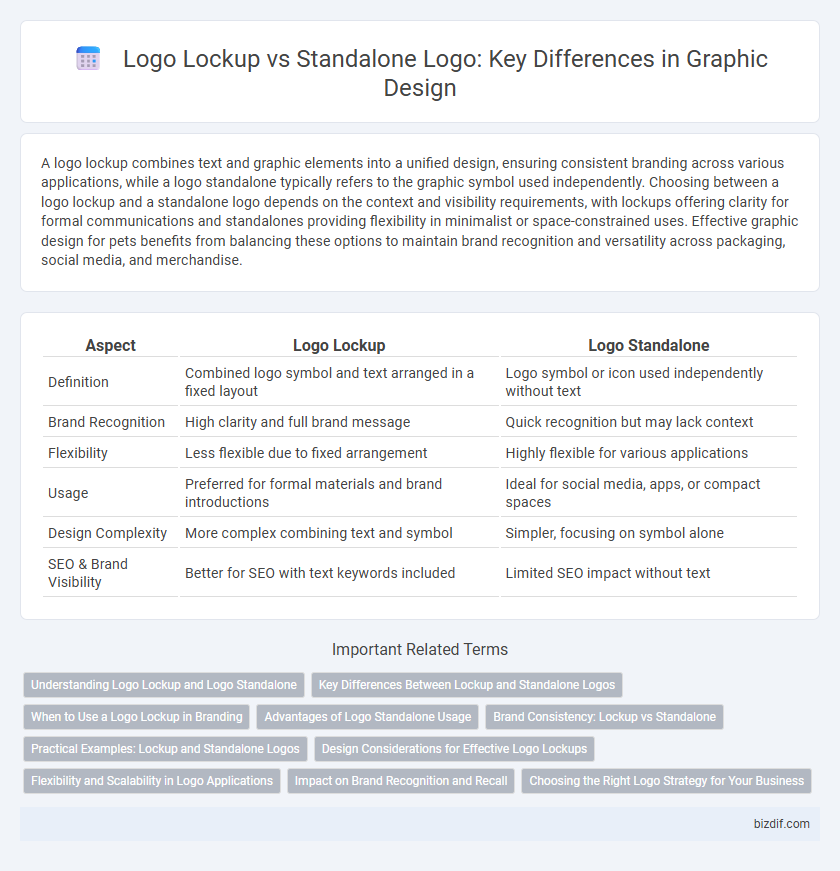A logo lockup combines text and graphic elements into a unified design, ensuring consistent branding across various applications, while a logo standalone typically refers to the graphic symbol used independently. Choosing between a logo lockup and a standalone logo depends on the context and visibility requirements, with lockups offering clarity for formal communications and standalones providing flexibility in minimalist or space-constrained uses. Effective graphic design for pets benefits from balancing these options to maintain brand recognition and versatility across packaging, social media, and merchandise.
Table of Comparison
| Aspect | Logo Lockup | Logo Standalone |
|---|---|---|
| Definition | Combined logo symbol and text arranged in a fixed layout | Logo symbol or icon used independently without text |
| Brand Recognition | High clarity and full brand message | Quick recognition but may lack context |
| Flexibility | Less flexible due to fixed arrangement | Highly flexible for various applications |
| Usage | Preferred for formal materials and brand introductions | Ideal for social media, apps, or compact spaces |
| Design Complexity | More complex combining text and symbol | Simpler, focusing on symbol alone |
| SEO & Brand Visibility | Better for SEO with text keywords included | Limited SEO impact without text |
Understanding Logo Lockup and Logo Standalone
Logo lockup refers to the specific arrangement of a logo's elements, such as the symbol, typography, and tagline, designed to maintain consistent branding across various applications. In contrast, a logo standalone features only the primary symbol or icon without accompanying text, allowing for flexible use in contexts where space or simplicity is essential. Understanding the distinction between logo lockup and logo standalone helps ensure effective brand recognition and cohesive visual identity across different mediums.
Key Differences Between Lockup and Standalone Logos
Logo lockups combine multiple visual elements like icons, logotypes, or taglines into a fixed arrangement, ensuring consistent brand presentation across various platforms. Standalone logos consist of a single graphic symbol or wordmark designed to be impactful without additional elements, offering greater flexibility in size and application. Understanding the differences helps designers choose the appropriate format for brand recognition and adaptability in digital and print media.
When to Use a Logo Lockup in Branding
A logo lockup combines the logo symbol with text elements like the brand name or tagline, creating a cohesive visual unit that strengthens brand recognition. Use a logo lockup in branding when clarity and immediate brand identification are essential, especially in digital platforms, packaging, and marketing materials where the connection between symbol and name must be explicit. Standalone logos work best in minimalist settings or for established brands with high visual recognition, but lockups enhance brand consistency during initial brand-building phases.
Advantages of Logo Standalone Usage
Logo standalone usage offers greater versatility and scalability across diverse media, ensuring consistent brand recognition even in limited spaces like social media avatars or mobile app icons. It enhances brand memorability by focusing on core visual elements without clutter, facilitating quick identification and stronger emotional connections. This approach also simplifies design implementation and reduces the risk of distortion or legibility issues present in complex lockup arrangements.
Brand Consistency: Lockup vs Standalone
Logo lockups combine the logo symbol with typography in a fixed arrangement, ensuring consistent visual identity across multiple platforms and materials. Standalone logos, typically just the symbol, offer flexibility but risk inconsistent brand recognition if not paired with standardized guidelines. Maintaining brand consistency requires strategic use of lockups for formal applications and standalone logos for adaptable, space-constrained scenarios.
Practical Examples: Lockup and Standalone Logos
Logo lockups combine a brand's name and symbol into a unified design, enhancing brand recognition across marketing materials such as business cards and website headers. Standalone logos, often just an icon or symbol, excel in minimalist applications like social media avatars and app icons where space is limited. Practical examples include Nike's swoosh as a standalone logo and Coca-Cola's script combined with its emblem in lockup form for greater identity clarity.
Design Considerations for Effective Logo Lockups
Effective logo lockups require careful consideration of hierarchy, spacing, and alignment to ensure brand elements cohesively communicate identity across various applications. Designers must balance size and proportion between the primary logo symbol and accompanying text to maintain legibility and visual impact. Consistent use of clear space and scalable vector formats enhances adaptability and preserves brand recognition in diverse media environments.
Flexibility and Scalability in Logo Applications
Logo lockups offer structured combinations of text and symbols that ensure brand consistency across diverse marketing materials, providing flexibility in multi-element layouts. Standalone logos, typically symbol or icon-based, excel in scalability and adaptability for smaller or digital formats where space is limited. Choosing between lockup and standalone formats depends on application needs, with lockups supporting detailed branding and standalone logos enhancing recognition in compact or variable-size contexts.
Impact on Brand Recognition and Recall
Logo lockups, combining symbols and text, enhance brand recognition by creating a unified visual identity that aids recall across diverse platforms. Standalone logos, often symbol-only, deliver immediate brand impact through simplicity and versatile application, but may require stronger initial brand association to boost recognition. Effective brand strategies balance lockup clarity with standalone logo memorability to maximize audience engagement and recall.
Choosing the Right Logo Strategy for Your Business
Selecting the right logo strategy hinges on understanding the distinct roles of logo lockups and standalone logos in brand identity. Logo lockups, which combine symbols and wordmarks, offer versatility and clarity across diverse applications, enhancing brand recognition. Standalone logos provide simplicity and strong visual impact, ideal for businesses aiming for minimalist aesthetics and quick brand recall.
Logo lockup vs Logo standalone Infographic

 bizdif.com
bizdif.com